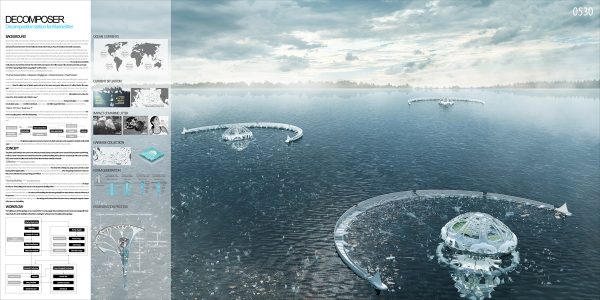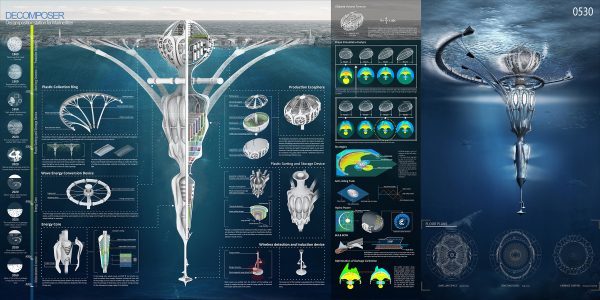Editors’ Choice
2020 Skyscraper Competition
Yilei Nie, Xibeini Luo, Bo Gao, Huan Wang
China
BACKGROUND
Beyond the landfills and trash heaps moldering in almost every town and city across the globe, manmade garbage has found its way into the natural landscape on a mind-boggling scale. It seems as though there are virtually no places left on Earth free of our rubbish. Junk can be found everywhere from the bellies of animals and the tissues of our own bodies to the world’s vast oceans. We are in a recycling system with other living things. As Marine garbage producers, we are bringing disasters to other living things and gradually destroying our own lives. What we throw away is gradually returning to us. It is urgent to improve the Marine environment and recycle Marine litter.
CONCEPT
The plastic trash floating in the ocean is not stationary. Instead, it keeps moving with ocean currents. If it is just point-to-point fishing, it will cost a lot of manpower and material resources. We conceived a building that could move continuously with ocean currents. It uses ocean currents to collect trash and turn it into other harmless materials as it travels.
Collection–Use of ocean currents
Collecting garbage is the most important step toward solving the problem of Marine garbage, which we already know forms garbage patches on the surface of the ocean due to ocean currents. The device like a fishing net, using ocean currents to catch floating Marine plastic debris. The pressure sensor inside the garbage collection device, when the garbage reaches the maximum that can be collected, the corresponding part will float, allowing the garbage to passing through the pipeline to the next step of the process.
Floating Building –A tumbler in the sea
When we move the building from the land to the sea, according to the relationship between buoyancy and volume, the larger the volume of the building in the sea, the more buoyant the building will be, and the floating of the building in the sea will be more stable. Therefore, the building in the sea is a building that grows downward from the sea surface. As the pressure in the seawater increases with the depth of the sea, the volume of the building also decreases gradually from top to bottom under the influence of the pressure. In order to make the building able to withstand frequent storms at sea, we added a closed space that can be opened and closed at the sea part of the building, so that the airbags can be closed when the storm comes, reducing the negative impact of the storm on the building.
In a word, this building is a Decomposition station for Marine litter floating on the sea, which can make marine litter be collected, crushed, transported and sorted into plastic raw materials. Then the plastic raw materials will be used for energy supply and industrial production. This building has a complete recycling circle, energy supply circle, industrial production circle so that it can complete the whole process of recycling Marine plastic litter.

















